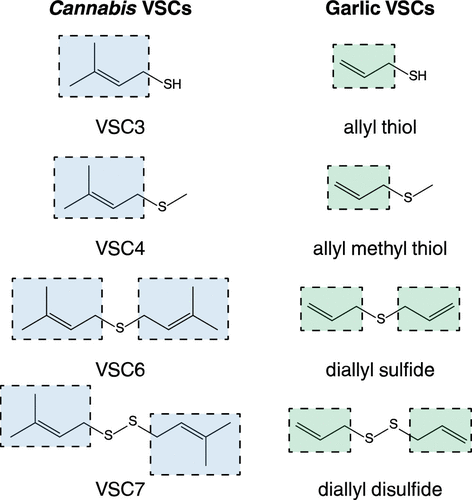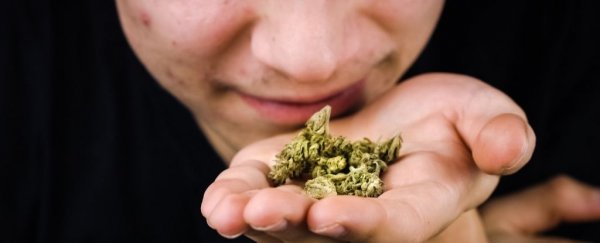With the dawn of legal cannabis in some US states, the number of Americans smoking, ingesting or applying the psychotropic drug has more than doubled in the last decade – and yet we are still lacking basic facts about the plant.
Only now are scientists getting closer to teasing apart which of the many chemicals in cannabis are responsible for different 'strains', and why they seem to give people unique highs when combined in different ways.
Until recently, we didn't even know which of the hundreds of metabolites found in cannabis give the flower its iconic 'skunky' smell.
According to a recent analysis of 13 cannabis strains, it now appears this pungent odor comes from a family of volatile sulfur compounds (VSCs), which have not been identified in nature before, but closely match those found in garlic.
Other volatile organic compounds, like terpenes, have been found to give cannabis a distinct smell as well.
Terpenes are often found in other aromatic plants, like lavender and rosemary, but previous research suggests they only contribute about half of cannabis' overall aroma, and there's little evidence linking them to a skunky scent. High amounts of terpinolene in the OG Kush strain, for instance, tend to give the flower a woody or citrusy aroma instead of a sulfury one.
To uncover the chemical origins of the skunk scent in particular, researchers measured and analyzed the various strong-smelling metabolites found in cannabis flowers and also in concentrated cannabis extract.
The team was specifically looking for VSCs, because these compounds are also found in skunk spray and other smelly plants like hops and garlic.
The findings ultimately uncovered numerous, novel VSCs associated with the iconic smell of weed. The compounds, known as VSC3 through VSC7, all show a similar structural organization to garlic VSCs, as can be seen in the image below.

That's an important finding because in garlic, these compounds might have potential health benefits, including anticarcinogenic properties and improved cardiovascular health.
"The structural similarities between VSCs in cannabis and garlic thus warrant further investigation to determine if the former possess similar health benefits to those of the latter," the authors write.
For the study, four members of a smell-testing panel were relied upon to rate the actual smell of cannabis flowers and cannabis extracts being researched. These ratings were then compared to the chemical make-up of VSCs in each.
In particular, there seems to be a strong correlation between VSC3 concentrations and the 'skunk-like' aroma detected by the panel.
Other VSCs appeared at lower concentrations when the skunk smell was around, although these chemicals were quite varied between strains.
Some were only found in one cultivar, while VSC3 stayed consistently linked to the skunk smell right across all the different breeds.
But that doesn't necessarily mean VSC3 is the only one that bestows a sulfury smell. The role of these compounds in an odor is complicated and depends on what other VSCs are present.
At high concentrations, for instance, VSC3 smelled skunky to the panel, but when the top ten VSCs were added together in a vial, the panel rated the smell as "mildly reminiscent of a flower", with no whiff of sulfur.
Adding VSC3 at a low, 1 percent dilution, on the other hand, immediately resulted in a smell change that "strongly emulated the scent of a flower."
"Interestingly, although VSC3 evaluated independently had a sulfuric, skunk-like aroma, the combination of the formulation and VSC3 was described most closely to the characteristic scent of cannabis, indicating that the combination of VSCs and other major components combine synergistically to yield this scent," the authors conclude.
Another interesting finding is what happens when VSC3 is combined at high concentrations with VSC5, as is common in cannabis extracts. In this case, VSC5 tends to give the skunky odor of VSC3 an even smellier boost.
This could help explain why cannabis extract can still be quite smelly, even after the flower has been converted into an oil.
When researchers grew cannabis strains in a greenhouse, they found VSCs increased substantially as the plant began to flower. These compounds hit their highest concentrations when the flower was being cured and dried out. A week after storage, the VSC concentrations began to drop.
"In particular, the drop in VSC3 concentration suggests rapid volatilization, which most likely contributes to the extremely diffuse and detectable aroma associated with cannabis," the authors write.
The team hopes further research can now delve into the potential medicinal properties of VSCs and whether the sulfury smell of weed holds any health benefits.
The study was published in ACS Omega.
